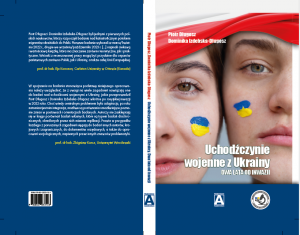Separated families in Ukraine during the war
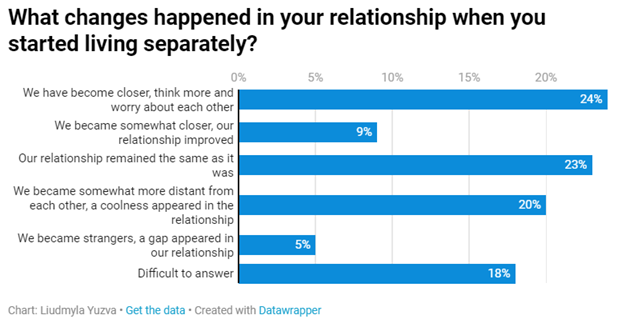
Today we publish an important text written by dr Luydmila Yuzva about the separation of Ukrainian families.
Ukrainian society was aware of the problem of separated families in connection with migration processes. It was especially acutely discussed within the framework of the issue of Ukrainian women’s migration to European countries in the 1990s and 2000s. Then attention was focused more on the problem of remote motherhood. In the gender field, this caused a rethinking of the status-role set in families, as well as the practices of cohabitation of partners in the family. However, with the beginning of the full-scale invasion of the Russian Federation on the territory of Ukraine, the problem of separated families became one of the most significant among all problems caused by military actions. According to IOM data, 7.8 million families were forced to separate from their relatives.

Source: IOM UN Migration, July-August 2022
Of course, such data obviously include completely different types of „disconnections”: according to the criterion of territorial separation
- part of native people remained in Ukraine, and part migrated abroad;
- part of the native people remained in one region of Ukraine, while the other part lives in another; according to the criterion of consanguineous separation
- adult children separated from their elderly parents (often the elderly stayed in their own homes while the younger generations escaped);
- husbands separated from their wives.
This classification can be continued with a large number of types of disconnection, but since there are currently no statistical data on such types of disconnection, only the most significant ones are given.
According to the data of the 4Service Ukraine study as of December 2022, 26% of respondents indicate that they are still separated from some members of their families.

Source: 4Service Ukraine, December 2022
Women with children and other categories of Ukrainians who went abroad with the beginning of the war became the object of many studies within the subject field of migration. The experiences of families that became separated families within Ukraine remained unstudied. So, during September 13-28, the research company Active Group conducted a survey in which 605 female respondents who had the experience of living separately from their husbands from February 24, 2022 took part. The project was carried out by the Interdisciplinary Analytical Center for Socio-Economic Welfare and Mental Health of Taras Shevchenko Kyiv National University. The study was conducted within the framework of the Initiative for the Development of Analytical Centers in Ukraine, which is carried out by the International Renaissance Foundation in partnership with the Open Society Initiative for Europe (OSIFE) with the financial support of the Embassy of Sweden in Ukraine.
Given the martial law conditions, the research used a self-administered questionnaire as a data collection method. The questionnaire contained 25 meaningful questions of various formats (closed, tabular, open, with scales) and an introduction and socio-demographic questions. Questionnaire questions related to: the duration and geography of a woman’s experience of living separately from her husband, changes in relationships during separate living, mental health of women and children (in part), the economic situation of a separated family. The block of questions related to socio-demographic features included questions about the woman’s age, the status of her relationship with her husband, and the number of children.
The results of the research showed that similar to the time when women (mothers) went abroad with their children to escape the war, the same process took place within the borders of Ukraine. 91% of female respondents said that their children lived with them during the period of living apart from their husbands. This division returns research attention to the distinction between motherhood as an institution (motherhood) and as a practice (mothering), which was first outlined by Adrienne Rich in the work „Of Woman Born: Motherhood as Experience and Institution” (1976). A broad overview of the main works devoted to views on motherhood is presented in Olena Strelnyk’s article „Motherhood: Oppression or New Opportunities? A Feminist Theory Response” (2018).
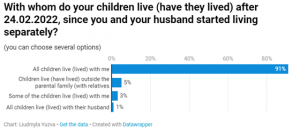
However, it is not correct to explain that the flight from the war to other regions of Ukraine of women with children is determined solely by the norms of the patriarchal society. Obviously, it should be taken into account that with the beginning of a full-scale war, martial law was introduced in Ukraine, which provided for some restrictions on men’s movement, a large number of men joined the ranks of the territorial defense of their settlements, many men began to perform public/public tasks that appeared as a result of the war. Of course, the influence of the patriarchal system cannot be rejected, but the war period adds specifics to it.
One of the biggest dangers that demographers and sociologists began to discuss was the danger of the destruction of families due to the fact that they will live apart for a considerable period of time.
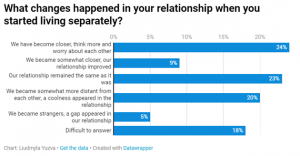
It is noteworthy that in the study we received a significant percentage of „non-answers” – 18% to the question about the relationship between partners in a marriage. This is an alarming indicator that may indicate that communication between partners in a marriage is broken, either because of the impossibility of establishing such communication due to the war, or because of insufficient desire to have such communication. Also quite significant are the shares of those whose relationships have deteriorated significantly (20%) and up to a critical feeling of a gap in the relationship (5%). However, 23% of female respondents maintained stability in their relationship, and even 33% (9% and 24%, respectively) noted that their relationship had improved. One of the biggest differences found in the study was the difference in women’s assessment of their position in society.
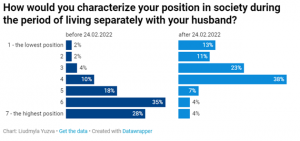
If until February 24, 2022, women who then lived in a family together with their husband marked themselves at high social levels – from 4 to 7, then after February 24, 2022 and the separation of families, they began to evaluate their social position – from 1 to 4. Of course. this division demonstrates not only the patriarchal framework in which a woman’s status depends on her marital status and living with a man. Undeniably, these data also reflect the general impact of the war on the position of women in society (families as a whole, etc.).
War and living in a divided family have a negative impact on the well-being and behavior of children. 21% of the women who participated in the study indicated that the well-being and behavior of their children significantly worsened. 46% of women noted that they had somewhat worsened.
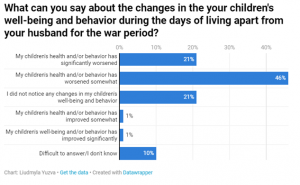
So for a mother, all the difficulties that appear during the war are aggravated by the deterioration of the children’s behavior and well-being.
The results of the research demonstrate a significant impact on both the mental health and a significant number of aspects of the social life of women who lived separately from their husbands during the war. They formed a separate vulnerable social group. At a time when the majority of Ukrainians in connection with the war in the country experienced such problems as: 1) falling into the trap of a postponed life, 2) receiving experiences of aggression in the family and outside its borders, 3) lack of planning or „loss of the future” which leads to psychological problems, 4) economic impoverishment and many others, women in divided families received an additional burden of guardianship and care, management of social and financial life.

